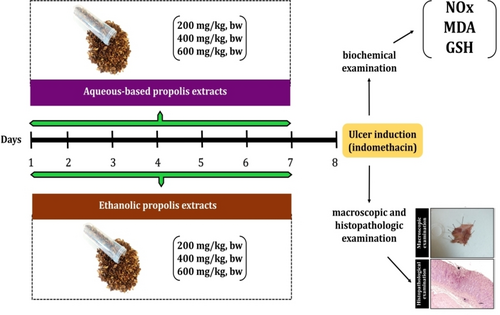Comparison of Protective Effect of Aqueous and Ethanolic Extracts of Propolis against Gastric Ulceration in Rats
Abstract
This study focused on the protective effects of different types of propolis extracts on gastric mucosa in indomethacin-induced rats. The animals were divided into nine groups: control, negative control (ulcer), positive control (omeprazole), and experimental groups, which were summarized by 200, 400, and 600 mg/kg, bw for aqueous-based and ethanol, respectively. According to the histopathological evaluation, more than others, the doses of 200 and 400 mg/kg of aqueous-based propolis extracts had different degrees of positive effects on the gastric mucosa. Generally, the biochemical analyses of the gastric tissue showed a correlation with microscopic evaluations. According to the phenolic profile analysis, while pinocembrin (684.34±1.70 μg/ml) and chrysin (540.54±9.06 μg/ml) were the most abundant phenolics in the ethanolic extract, ferulic acid (53.77±0.07 μg/ml) and p-coumaric acid (52.61±0.42 μg/ml) dominated the aqueous-based extract. Also, the total phenolic content (TPC), total flavonoid content (TFC), and DPPH radical scavenging activity of the ethanolic extract showed almost nine-fold superiority compared to the aqueous-based extracts. Based on data from preclinical data, it was decided that the best doses for the main goal of the study were 200 mg and 400 mg/kg, bw for aqueous-based propolis extract.
Graphical Abstract
Conflict of interest
The authors declare no conflict of interest.
Open Research
Data Availability Statement
Research data are not shared.





